Abstract
There is an increasing demand for green plant walls in indoor environments because of their multifaced benefits, such as aesthetic appeal, indoor air quality improvement, or psychological well-being. Mosses are believed to be excellent for these walls due to their easy application and maintenance. However, so far there is no evidence for their indoor survival. In this study, we tested the moss species Hypnum cupressiforme, Bryachythecium rutabulum, Eurrhynchium angustirete, Thuidium tamariscinum, Streblotrichum convolutum, Syntrichia ruralis, and Ceratodon purpureus for indoor use in living moss walls. We evaluated their vitality through the monitoring of leaf coloration over a twelve month period, subjecting them to varying temperature ranges (14–20 °C), humidity levels (60–100%), and diverse irrigation methods (drip and spray irrigation, 300–1500 mL per day) within controlled climate chambers. Depending on the combination of these variables, mosses survived up to six months. Hypnum cupressiforme and Ceratodon purpureus performed best. However, as the time span of survival was limited, the use of living mosses for indoor purposes at the current stage cannot be recommended. An additional problem is that the requisition of living material such as in the culturing of moss under horticultural conditions is difficult and harvesting from natural environments is detrimental to most habitats.
1. Introduction
Urban green space and indoor greenery have received a substantial amount of attention in relation to human health. Both have the potential to help address a wide series of health issues in a preventative way [1]. The growing concern regarding the health of people living in urban environments is further exacerbated by the rapid urbanization that has characterized the 21st century [2]. Urban populations are estimated to spend about 90% of their time indoors [3], underscoring the importance of indoor greenery.
Mosses experience a positive perception by the urban population in many respects [4], making them a compelling choice for indoor greening systems. This is especially true as mosses offer a diverse range of benefits:
- Humidity control:Living mosses are known to be effective at regulating humidity in a dry environment, which can help mitigate health issues associated with low humidity levels. These health issues include the desiccation of mucous membranes, heightened susceptibility to colds, eye and skin issues, as well as the manifestation of electrostatic charging and discharging phenomena in low-humidity environments, particularly during the winter season [5,6,7]. Research examining the impact of relative humidity on disease development dates back to the 1960s [8].
- Noise reduction:Noise is another type of environmental stressor and has detrimental effects on human health [9]. Noise raises stress levels and reduces the restorative quality of the home environment [10]. Green walls can reduce artificial noise through an acoustic mechanism [11,12]. Researcher Van Renterghem calls this mechanism an example of the “micro-restorative experiences” that can be found at the work place, in hospital environments or at schools. Moss walls could be a valuable contribution to the reduction of this stress factor by lowering the noise by 10 dBA [13].
- Air Filtration:Environmental pollution, particularly indoor air pollution, has emerged as a worldwide concern and a major environmental threat to health. The World Health Organization (WHO) estimated in 2020 that every year about 3.2 million people die from diseases related to indoor air pollution, mainly caused by cooking or heating [14]. Since the 1980s, studies have investigated the capability of mosses to absorb particulate and wet depositions [15,16,17], with a particular emphasis on their ability to absorb heavy metals and hazardous organic compounds. Mosses predominantly absorb particles ranging in size from 10µm to a few nanometers, which fall under the category of “fine dust”. This makes mosses efficient at collecting particulate matter (PM2.5, PM10) and earning them a reputation as fine dust collectors. This fact is widely known to the public and is frequently cited by commercial companies in the promotion of moss greening. Although this reduction of particulate matter by mosses does indeed occur indoors, this factor is sometimes overestimated. The reasons for this are an overestimation of the absolute surface area of mosses and the poor binding of dry deposited particles. In order to be completely fixed to the binding capacities of the outer cell walls, a wet deposition is needed, which does not exist indoors. Dry deposited particles can be easily remobilized by draughts, for example. Similarly, detoxification by mosses does not take place.
- Psychological benefits:The aesthetically pleasing and calming green appearance of mosses contributes to the creation of a biophilic indoor environment. This is an emerging approach to architecture and interior design, one that seeks to establish a connection between people and nature within indoor spaces. It incorporates elements of nature, such as plants, water features, and materials like wood and stone, into buildings and has been subject to extensive research in recent years. Numerous studies have indicated that biophilic design offers psychological benefits such as increased productivity, concentration, and general well-being [18,19,20,21,22].
In conclusion, the integration of indoor greenery holds substantial promise in addressing a wide spectrum of health challenges. Although mosses may not show a significant advantage over other plants in addressing these challenges, their aesthetic appeal has generated a significant demand for their inclusion in indoor greening systems.
1.1. Indoor Moss Walls
Previous attempts to keep bryophytes alive indoors have mostly failed. Bryophytes are one of the two major lineages within plants. They differ from all other plants in that they have no guiding vessels and therefore absorb water and nutrients over their entire surface. They can dry out completely and live again after being moistened. These properties make them extremely interesting for a wide range of applications. Mosses are one of the three lineages within bryophytes. There are many patents on indoor moss systems, mainly from the Asian region [23,24,25,26]. However, in none of these patents is there any information on the survival duration of bryophytes in these systems. If the duration of the test phases is given, it was short. For example, one study tested indoor bryophytes under tropical conditions for a period of 6 weeks [23].
Most commercially available moss walls currently contain stabilized, non-living mosses that are primarily treated with glycerin, to keep the natural appearance with no or little maintenance [27,28,29,30]. Although these walls can improve room acoustics and aesthetics, they neither photosynthesize nor produce oxygen. Furthermore, they do not enhance the indoor microclimate.
The few living “moss walls” that are available commercially are not actually composed of mosses, but rather reindeer moss (Cladonia subgen. Cladina), which are lichens [31]. The only thing mosses and lichens have in common is their ability to absorb water and nutrients from the air. However, mosses are plants, so they carry out photosynthesis, while lichens are a symbiosis of fungi and algae. We are thus dealing with different systematic kingdoms—the highest levels of classification of organisms. A manufacturer from America claims to be able to apply living mosses (Leucobryum glaucum) indoors [31]. On closer inspection, however, one sees that these mosses do not need water and light, which are prerequisites for plant-life, and therefore cannot be spoken of as “living moss walls”. Furthermore, many species (Cladonia subgen. Cladina and Leucobryum glaucum) used for moss walls are protected from commercial use in Europe according to European law and are listed in Annex V of the Habitats Directive [32].
Because the commercial demand for moss walls is high, it would be beneficial to create actual living moss walls that could provide noise reduction and humidity control. As such, our study aimed to establish fundamental knowledge on the conditions necessary for the integration of living moss in indoor greening systems.
1.2. Knowledge of the Optimal Conditions for Mosses
Keeping bryophytes alive in an artificial environment requires knowledge of the physiological optima and ecological amplitudes of the bryophyte species used.
Specific studies on the physiological optima of bryophytes date primarily from the heyday of plant physiological research between 1970 and 2000, when experiments were primarily conducted on desiccation behavior [33,34,35]. Among other things, it was found that the desiccation phase and also the rewetting must be slow [36,37], otherwise, the bryophytes will die rapidly. The growth of bryophytes, as with all plants, is tied to turgescent cells. However, bryophytes can often survive extended periods (up to several years) in desiccated conditions [23,38,39]; however, this is not true for all moss species. It is widely accepted that the best way to maintain moss is to water regularly for short sessions each day rather than long drenching soaks weekly [40].
Experiments and in situ studies concerning temperature and light intensity are less frequent compared with those on water balance. Nevertheless, according to the available studies, the temperature optima for most bryophytes in a hydrated state falls within the range of 15 °C to 25 °C. Most bryophytes of temperate climates have their optimum around 20 °C, whereas Bryophytes of tropical locations go up to 30 °C [41,42,43,44,45,46,47]. Temperatures above 30 °C are lethal to all bryophytes in the wet state over the long term [42]. In the dry state, however, bryophytes can endure tremendous extremes of temperature (from −150 °C to +60 °C) [44]. The range of variation in light optima is species-dependent and large but appears to have an optimum between 2000 and 4000 lux for a variety of species [48]. There is a positive correlation between usable light amount and temperature.
From all of these experimental approaches, conclusions can be drawn for the growth preferences of individual moss species; though, like any experimental approach, they cannot account for all factors that occur in nature. Monocausal experiments disregard multicausal relationships or are usually unable to represent influences from the living environment. Therefore, much of the information on the growth conditions of individual moss species still comes from the observations of bryologists working in the field. The physiological preferences of individual moss species can be inferred from real-site conditions. Numerous publications, including those on moss species occurring in Austria, show these distribution patterns [49,50,51].
Based on this knowledge, our research project investigated the cultivation, maintenance, and propagation of living mosses under laboratory conditions, in order to enable their application in sustainable greening systems. Specifically, our research focused on defining the parameters, such as temperature, humidity, and light, that are essential for the growth and vitality of mosses.
2. Materials and Methods
2.1. Moss Selection
The selected bryophytes were expected to grow well in indoor conditions. The selection was based on the literature mentioned and the comprehensive knowledge of the first author of the site ecology of mosses. The material taken from nature was harvested with the greatest possible protection of the stands in very moss-rich regions. We took care to ensure that the material was restricted to single species collections, and that no rare or other mosses were interfered with. Mosses from the outdoor collection were taken from siliceous rocks as well as from forest floors, both over silicious and base-rich bedrocks. We collected the following mosses: Hypnum cupressiforme Hedw. var. cupressiforme, Brachythecium rutabulum (L. ex Hedw.) Schimp., Eurhynchium angustirete (Broth.) T. J. Kop., Thuidium tamariscinum (Hedw.) Schimp.
A part of the material was cultivated by the company Reinhold Hummel GmbH + Co. KG, Stuttgart. Mosses grown in cultivation are as follows: Streblotrichum convolutum var. sardoum (Bruch and Schimp.) Podp, Syntrichia ruralis (Hedw.) F. Weber and D. Mohr and Ceratodon purpureus (Hedw.) Brid.
For further descriptions of the species and their ecological requirements, please refer to the relevant specialist literature [52].
2.2. Moss Panel Construction and Panel Compositions
In the course of the study, we tested different moss panels. The panels differed primarily in the stocking of different moss species and different sources for these moss species.
All moss panels were constructed using a water-repellent screen-printing plate measuring 60 cm in width and 80 cm in height and placed in an upright position. Hygrolon, renowned for its water-draining and water-storing capabilities, was chosen as the substrate. The moss was then affixed to the panels using a hail net. This involved draping the net over the moss and suspending it from nails screwed into the sides of the screen-printing plates. Additionally, to prevent any shifting of the moss, cable ties stabilized the nets at central points.
2.2.1. Panels 1–3 (Figure 1)
On Panels 1–3, mixed species populations of Hypnum cupressiforme, Brachythecium rutabulum, Eurhynchium angustirete and Thuidium tamariscinum were applied. The origins of the species were different. Mosses on Panel 1 were harvested from silicious rocks, mosses on Panel 2 were obtained from a forest floor over silicious bedrocks and mosses from Panel 3 were obtained from a base-rich soil.
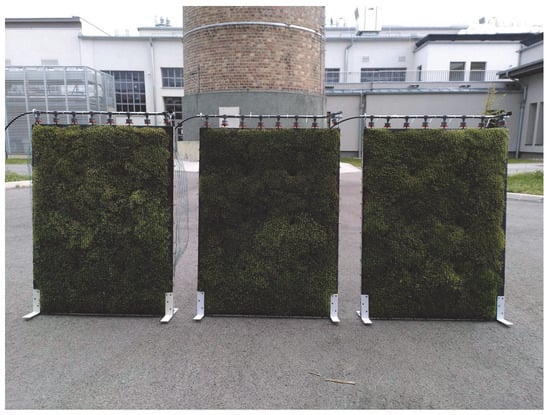
Figure 1.
Panel 1 (left), Panel 2 (middle) and Panel 3 (right); all panels are equipped with the following moss species: Hypnum cupressiforme, Brachythecium rutabulum, Eurhynchium angustirete and Thuidium tamariscinum.
2.2.2. Panel 4 (Figure 2)
On Panel 4 only Hypnum cupressiforme from a silicious rock was applied.
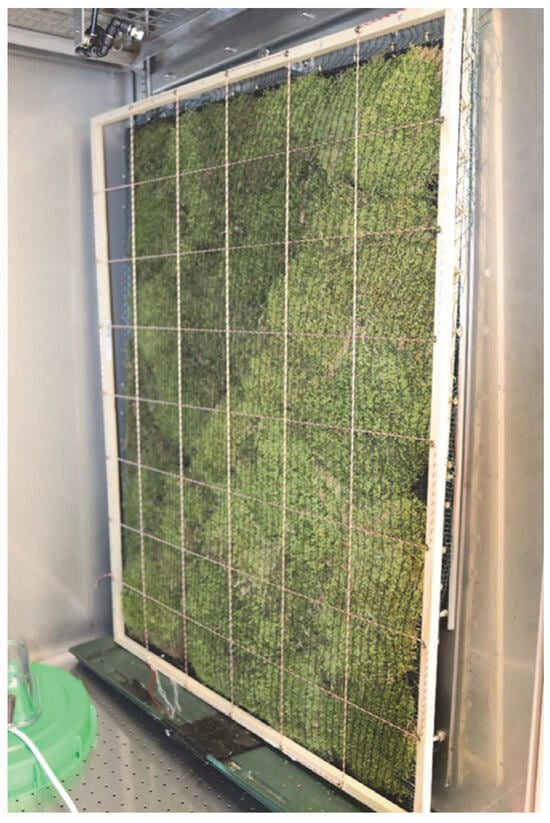
Figure 2.
Panel 4, equipped with the moss species Hypnum cupressiforme and covered by the monitoring net.
2.2.3. Panels 5–7 (Figure 3)
Mosses from Panels 5–7 were derived from horticulture. Panel 5 was a small patch of Hypnum cupressiforme, Panel 6 was a large lawn of Streblotricum convolutum and Panel 7 was a mixture of the mosses, dominated by Ceratodon purpureus, Bryum capillare agg., Syntrichia ruralis and Amblystegium serpens.
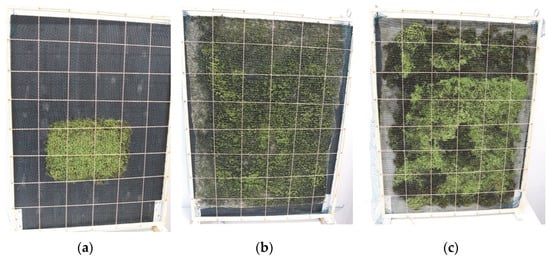
Figure 3.
(a) Panel 5 (Hypnum cupressiforme); (b) Panel 6 (Streblotricum convolutum); and (c) Panel 7 (mixture of the mosses, dominated by Ceatodon purpureus, Bryum capillare agg., Syntrichia ruralis and Amblystegium serpens); all mosses derive from horticulture.
2.3. Monitoring Method
To quantitatively assess the development of the moss panels, each panel was subdivided into a 10 × 10 cm grid. Fifty percent of the subplots were selected to ensure equal coverage of all moss species (Figure 4). These subplots were photographed weekly in a standardized manner. From these photographs, we manually determined the percentage of moss leaves that appeared healthy, yellow discolored, or brown discolored (indicating death). We also took note of the following potential observations:
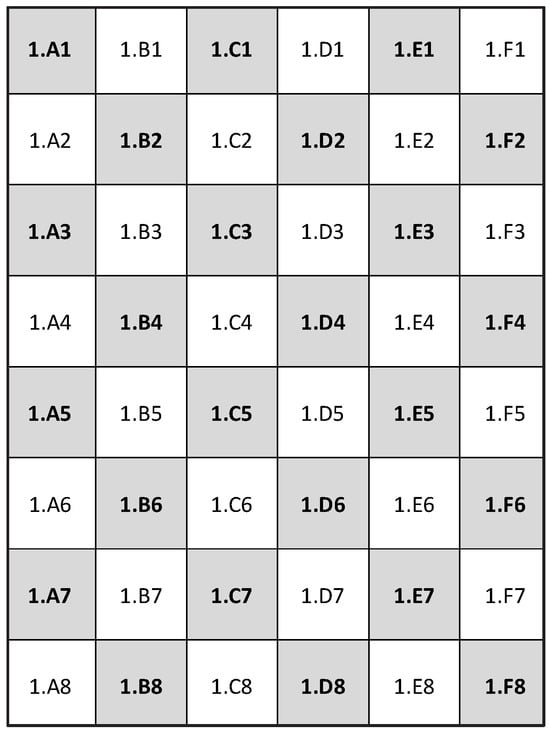
Figure 4.
Monitoring scheme—only grey fields were documented.
- -
- Efflorescence of minerals on the surface of leaves (in %)
- -
- Growth of new leaves (in %)
- -
- Growth of new stems/branches (in %)
- -
- Occurrence of fungal filaments (in % or “sporadic”)
- -
- Occurrence of algae on leaves/stems (in % or “sporadic”)
- -
- Occurrence of algae on the hygrolon surface (in % or “sporadic”)
In addition, a tactile assessment of the moisture on the surface of the mosses (top, middle, bottom) was made each week according to the following categories: dry, moist, and wet.
2.4. Climate Chamber
In order to find the ideal combination of parameters for the growth and maintenance of living moss, the moss panels were tested in a double test chamber manufactured by Feutron Klimasimulation GmbH. This allows for the precise control of humidity and temperature, as well as the installation of various irrigation and lighting systems.
2.5. Irrigation System
The irrigation System supplied the moss panels with purified water from the reverse osmosis system of OSMOTECH GmbH. The water was stored in a tank and pumped to the installed irrigation system at specific times. To ensure the quality of the water, pH levels were frequently measured.
Three different irrigation systems with varying watering periods were tested:
- Drip irrigation:
First, a stepwise adjustable irrigation system from Gardena GmbH was chosen. Each panel was equipped with eight drippers on the top. The irrigation hose was fixed to an aluminum bar which was attached to the upper edge of the panel by two screwed-in metal eyelets, depicted in Figure 5.

Figure 5.
Drip irrigation at the upper end of the panel.
Three times throughout the day, the system watered the moss panel for 15 s each.
- Fixed spray irrigation:
At the beginning of November 2021, it was decided to start a new experimental setup with a fixed spray system to ensure uniform watering of the entire area. The spray system consisted of two spray heads that were used to irrigate Panel 1 from above, as shown in Figure 6. Watering frequency was increased to five times per day for 2 min each to ensure adequate watering. This corresponds to a water volume of 370 mL a day.
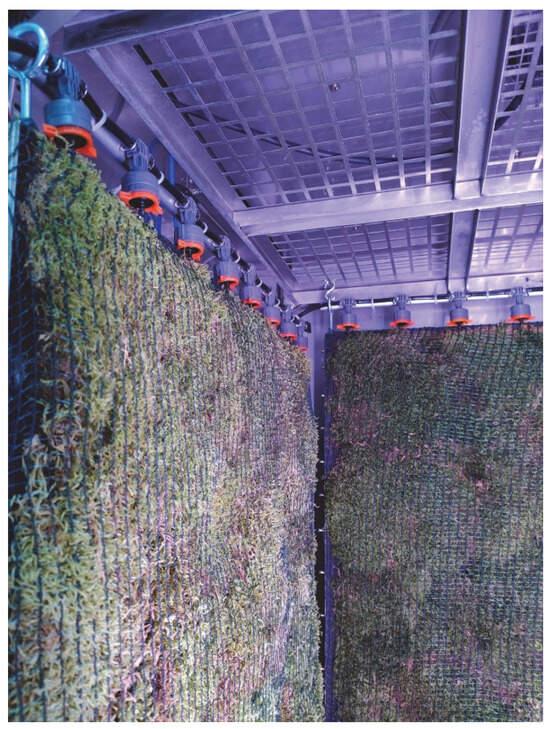
Figure 6.
Fixed spray irrigation at the upper end of the panels.
- Movable spray irrigation:
With spray irrigation, a more even watering could be achieved compared with drip irrigation, but certain areas remained too dry; in particular, the lower half of the panels were insufficiently moistened. To counteract this, a movable spray system was developed and installed in December 2021 for Panel 4 and the following panels. Figure 7 shows this system mounted on the right side.
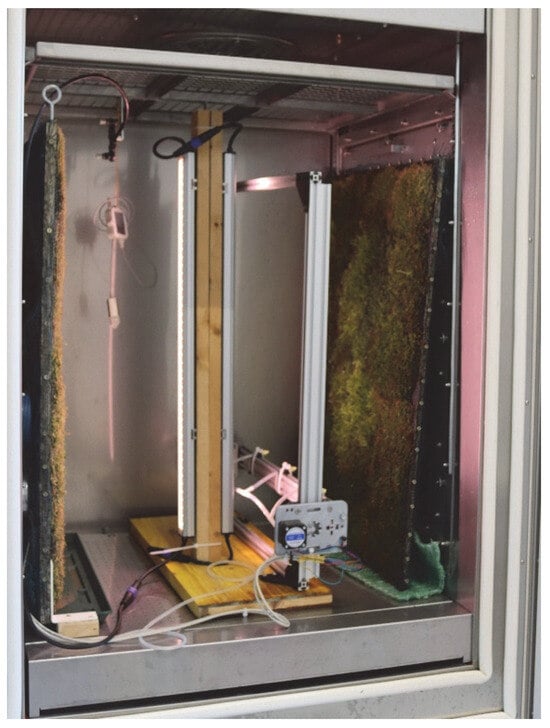
Figure 7.
Moveable spray irrigation on the center-right side.
At first, the watering frequency remained the same. In January, however, waterlogging formed in the lower area and fungal threads emerged sporadically. In addition, new spray heads were installed in February, which sprayed more water than the previous ones. Therefore, the number of watering rounds was halved and were further reduced in April due to increased fungal appearances.
In May, with the installation of Panels 5, 6 and 7, the irrigation was changed so that 8 runs were carried out before the lighting was switched on, in order to resemble the conditions in which the mosses were cultivated. With this method, however, waterlogging formed again in the lower area due to gravity. Consequently, the number of runs was reduced to four, with one run covering the entire surface and the other only the upper half. This proved to be the best solution and was therefore maintained until the end of the project.
All changes in irrigation for this system can be seen in Table 1; the watering amount in the last row is given per panel and day.

Table 1.
Parameters and their changes in the course of the study for the setup of the movable spray irrigation.
2.6. Parameter Changes
All parameters were programmed to reflect the natural day/night cycle. To ensure that the programmed parameters in the climatic chamber corresponded to the actual ones, they were recorded and checked regularly. In the event of changes to the experimental setup, the data were also compared with an external measuring device.
2.6.1. Light
A vertical lighting system was installed with three LED lamps from SANlight GmbH. We ensured that the angle of incidence of the lamps on the panels could be adjusted by simply turning them. The lamps were aligned in such a way that the lighting intensity was as homogeneous as possible.
Initially, the light intensity was set at 1200 lux. The lighting was repositioned in mid-December to radiate from the center of the chamber and the light intensity was therefore decreased to 700 lux. However, in the first quarter of 2022, Panel 4 showed a significant decrease in vitality. To improve the conditions, the light intensity was gradually increased back to 1200 lux. At the beginning of May, to facilitate the needs of the new mosses on Panels 6 and 7, the lighting was switched on between 06:00 and 22:00 and increased to 4000 lux. Then, from 20 May 2022–1 June 2022, the luminance was gradually increased over a period of 3 weeks to a maximum of 6000 lux, as seen in Table 2.

Table 2.
Parameters and their changes in the course of the study for the setup of lighting.
2.6.2. Humidity
Due to the significant fungal growth during the initial few weeks, the humidity levels were lowered to 50% and 60% (refer to Table 3). Although this approach was effective, a new setting was tried in December. This involved changing the humidity to 90% every three days. The three-day cycle was discontinued in April 2022 due to fungal growth on Panel 4 and lowered to permanently 50%. Nevertheless, we resumed the three-day circle in May with the introduction of Panels 5, 6 and 7. Later, the development of these panels was tested with the 50% and 60% rhythm from the beginning.

Table 3.
Parameters and their changes in the course of the study for the setup of humidity.
2.6.3. Temperature
In a similar manner, various temperature settings were tested, as presented in Table 4. Initially, the temperature was lowered to reduce the fungi on Panels 2 and 3. In February, however, the temperature was gradually increased to 20 °C during the day and 16 °C at night, to simulate the conditions in an office environment. This was continued until the end of the project.

Table 4.
Parameters and their changes in the course of the study for the setup of the temperature.
3. Results
The course of the vitality of the individual moss panels is shown in Figure 8, Figure 9, Figure 10, Figure 11, Figure 12 and Figure 13. A distinction is made between the green (=vital), yellow (=reduced vitality) and brown (=dead) parts.

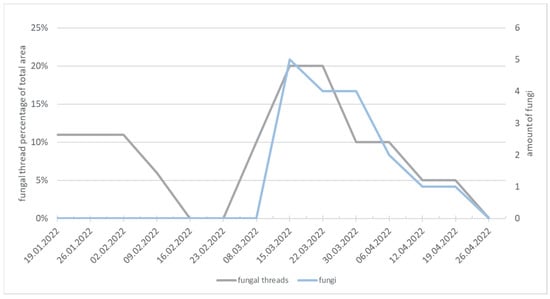
Figure 9.
Development of fungal threads and fungal fruiting bodies (fungi) on panel 4.
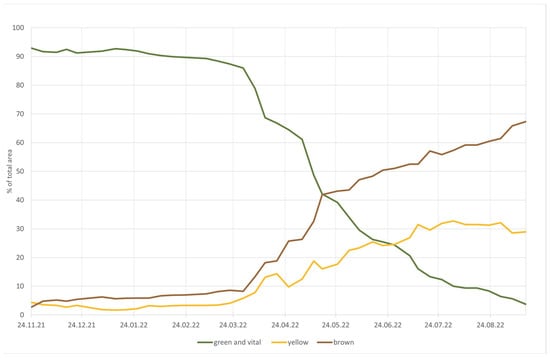
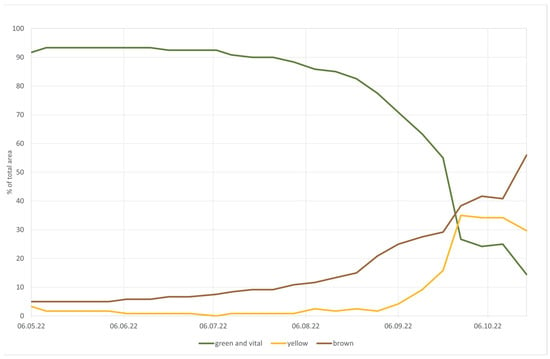
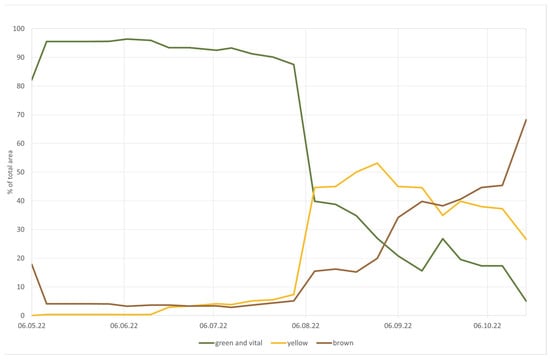
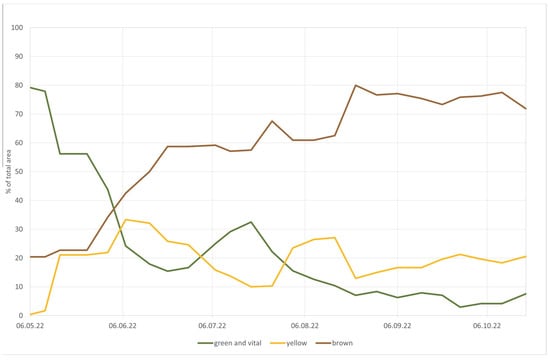
3.1. Vitality Development of Panel 1–3 (Figure 8)
Panel 1 shows the best performance of the three moss walls tested first. Panels 2 and 3, in contrast with Panel 1, suffered from severe fungal decay after only one week. As a result, both panels were removed from the climate chamber in October 2021 and placed outside to improve their conditions. However, within two weeks, 50% of the mosses were already yellow or dead on both walls. Therefore, only Panel 1 was examined further. As shown in Figure 8, the vitality of Panel 1 decreased steadily. During the first months of drip and spray irrigation, the percentage of green and vital mosses decreased sharply from 85% of the panel being healthy at the beginning to 50% after just 2 months. From this point on, Panel 1 was watered manually with a one-liter spray bottle every few days. After 5 months only 10% of the mosses remained vital, while 70% were yellow and the remaining 20% were dead. Consequently, Panel 1 was also moved outdoors.
3.2. Vitality Development of Panel 4 (Figure 9)
Panel 4 was shown to perform best among all of the collected mosses. Both the origin of the mosses (silicate rocks) and the optimized climatic conditions allowed a comparatively long survival of the mosses.
Two months after the installation of Panel 4, fungal threads emerged on the surface (see Figure 10). In March 2022, probably due to the increased watering amount, 20% of the panel was infected with fungal threads and a total of five fungal fruiting bodies were detected. However, with the reduction of watering in early April, the percentage of fungal threads, as well as the number of fungi, were successfully reduced.
As shown in Figure 9, in the first 4 months, nearly 90% of the panels were vigorous despite the presence of fungi, but by early April the vitality of the panels had declined significantly. After 7 months 50% of the mosses had died and after 10 months there were no more vital stems.
3.3. Vitality Development of Panels 5–7 (Figure 11, Figure 12 and Figure 13)
The cultivated mosses met a comparatively similar fate as those of the collection from natural stands. During the initial three months, mosses on Panels 5 and 6 showed no significant decline in vitality. However, both panels showed a decline in vitality from August 2022 onwards, despite the parameters remaining unchanged since the end of June. By mid-October, only 15% of Panel 5 and 5% of Panel 6 were vital. The vitality of the mosses in the mixed stand (Panel 7) varied greatly, Ceratodon purpureus showed vital shoots the longest, and Syntrichia ruralis also survived for a relatively long time. Nonetheless, no vital stems were found on this panel after 5 months.
4. Discussion
4.1. Favorable Moss Species
All mosses collected from soils were highly susceptible to fungal growth, whereas rock mosses were less susceptible under the same conditions. This is all the more astonishing because mosses growing in moist environments, like forest floors, have a higher proportion of antifungal agents than those of the dry substrates in which fungi do not grow as well [53].
In comparing the various moss species over the test period, we found that Hypnum cupressiforme and Ceratodon purpureus were established favorably. Both mosses have very wide ecological amplitudes and grow in nature on many substrates in every continent [54,55]. Nevertheless, under the optimized conditions set from about May 2022, six months appears to be the limit for moss survival under the adjusted laboratory conditions. We observed no difference in the development of cultivated and collected mosses during the tests.
In our study, moss mixtures were used in Panels 1–3 and Panel 7. A mixture of ecologically comparable mosses is expected to be more resilient due to microclimatic synergies between species, and therefore species that fail can be overgrown by species that thrive better. However, in our study, this did not show any significant benefit as no species showed any noticeable growth. To focus on moss mixtures (as opposed to pure mosses) would still be beneficial in further studies. The same applies to the study of mixtures of mosses with other plants.
Vertical application of horizontal growing mosses did not have a negative effect on growth habits for any species.
4.2. Optimal Light Intensity
With regard to light intensity, the needs of the respective moss species should be considered, and the intensity adjusted accordingly. Experiments have shown that optimal light intensities are in the range of 700–1900 lux at 25 °C for woodland species [34]. In our study lux values that were too low (<900 lx) had a negative effect on growth, whereas high levels (up to 6000 lx) did not negatively influence the moss growth. The latter was shown by Panels 5 to 7, which were tested under such a high light intensity. Uniform illumination of the moss panels by means of appropriately dimmable luminaires was relevant in our experiments too. Regarding the use of mosses in greening systems, indoors dark resting periods overnight should be observed. In contrast with field observations, continuous illumination had a negative effect on the stress level of the plants and led to death [56].
4.3. Optimal Irrigation and Humidity
Irrigation is one of the crucial points in indoor greening systems [57]. Mobile spray irrigation, which waters the mosses frontally, has established itself as the most promising variant in our study. Drip irrigation could not provide sufficient and uniform watering. Only those parts of the moss over which the water ran directly remained vital. Other areas turned yellowish, brown or were infected by fungi. Despite its natural manner of humidification [58], irrigation via the substrate was problematic. This manner primarily supplied water at the bases of the moss stems, which began to rot, while the viral growth peaks were not reached by the water and dried out. Spray irrigation by a medium amount of water was best because of the mechanical cleaning of the leaf surface. This process is assumed to remove fungal spores and hyphae which grow on the surface, preventing them from infecting new cells. It can also hinder the formation of sporangia. Furthermore, the water film on the surface of the mosses seals the cells, depriving oxygen-loving fungi of the oxygen supply they require.
Due to the mobile system, uniform humidification could be achieved, without the formation of waterlogging, when water amounts were small. As we substantially increased the water amount to 1500 mL per panel in mid-February, Panel 4 performed well for a few weeks, but then faced a rapid decline in vitality. Additionally, fungi appeared, indicating the adverse impact of excessive water. Decreasing the amount to 900 mL with watering three times per day worked well; however, the moss panel did not recover. Watering the panel once per day before turning on the light was seen to be effective, but it is crucial to reduce the total water amount to avoid waterlogging. Here, we found the optimal method was to start watering the panel from the top, down to the middle, before returning to the top again and then to the bottom.
In any case, when watering the plants, the strong correlation between humidity and the amount of watering must be considered. We achieved an air humidity of 95–100% at the first stage of our study. This was in accordance with another study, which tested moss growth chambers for eco-physiological studies [59]. Intensive fungal growth was one of the results. A lowering of air humidity to at least 60% during the night improved the situation.
A change in humidity throughout the day was positive, as it favored moss growth and counteracted fungal growth. However, a three-day cycle, consisting of two days with lower humidity levels (50–60%) and one day with higher humidity levels (80–90%), did not provide a significant advantage over the daily cycle.
4.4. Optimal Temperature
There are many studies regarding optimum temperatures for mosses with contrasting results [34,41,42,47]. The moss species used in our study generally prefer lower temperatures (18–25 °C). During the investigations, the temperature was gradually increased from 14 °C to 20 °C during the day and from 10 °C to 16 °C during the night in order to study plant growth at office environmental conditions. The increase in temperature seemed to have had a negative effect on the vitality of the plants and to have promoted the formation of mold. Therefore, the temperature was not raised above 20 °C. This poses a challenge to the suitability of live mosses in indoor greening systems.
4.5. Other
Molds were the dominant harmful organism during the research project. These are favored by a combination of high humidity and warm temperatures. Frontal spray irrigation inhibited fungal growth on growing tips. Occasional drying of the plants also helped to impede fungal growth. The definition of an optimal moisture-drying rhythm could be the subject of further research, as excessive drafts seem to dry out the plants and thus have a negative effect on growth.
Due to our unsuccessful attempts to keep the moss panels alive for long periods of time or, in other words, to reproduce the microclimatic conditions found in nature, the use of mosses in indoor greening systems cannot be recommended at this stage. It should also be noted that the presence of accompanying organisms, such as microorganisms, as well as microfauna like the arthropods, mollusks and nematodes that are found in their native habitats, is crucial to their survival. All these together provide an adequate environment in which the mosses can thrive. As the microfauna in particular are undesirable indoors, it will not be possible to set up functioning systems for the time being.
Regardless of the challenges in caring for the mosses, the problem of the origin of the plants for indoor greenery remains. Growing the plants requires expert knowledge, an appropriate infrastructure, and a lot of time. So far, only very few suppliers have succeeded in successfully cultivating mosses, as indoor cultivation faces similar challenges to our project, including problems with mold, lighting, and watering. The transfer of outdoor-cultivated mosses to indoor settings creates the same problems. Sustainable harvesting of mosses from nature is nearly non-existent and is only possible under the relevant guidelines for harvesting mosses [60]. However, large-scale removal of moss from its natural habitat seems unjustifiable, as it destroys the habitat of the thousands of microorganisms that live in the moss cushions and creates unfavorable sprouting conditions for a whole range of vascular plants. The issue of sustainability aside, there is still the problem of transfer when moss is taken from nature. A workable solution to these problems has not yet been found.
5. Conclusions
Despite the promising potential of moss in indoor greening, the challenges of maintaining their vitality were evident in our study. Fungi and mold growth, along with the difficulty of replicating ideal environmental conditions, remain major obstacles. Six months appeared to be the limit for moss survival. Conditions in that period were as follows: daily variation of temperature between 16 °C and 20 °C, daily variation of humidity between 50% and 80%, and light intensity between 4000 and 6000 lux. Hypnum cupressiforme and Ceratodon purpureus appeared to be established as relatively favorable species. Mixed collections of species did not perform better than single moss walls as no species showed noticeable growth. Mosses collected from soils had a strong tendency to become fungal, whereas rock mosses were less susceptible to fungal growth under the same conditions. The change in humidity during the day can be considered positive and seems to favor moss growth or at least keep fungal growth at bay. Spray irrigation from the front is preferable, not least because of the mechanical cleaning of the leaves.
Based on our results, the use of living moss for indoor greening cannot be recommended at the current stage. It is evident that more experiments are required to overcome the challenges associated with sustaining mosses in indoor environments. These should include a wider range of humidity and temperature parameters as well as the use of other species. Furthermore, the inclusion of a micro-grazer (e.g., Collembola) could foster moss survival. However, another problem—a sustainable source of the moss both for experiments and for indoor greening—has to be solved first.
Author Contributions
Conceptualization, H.G.Z., A.K., E.S., L.M., A.S, P.N.F. and E.H.; methodology, H.G.Z., A.K., E.S. and E.H.; software, A.S.; validation, H.G.Z. and A.K.; formal analysis, H.G.Z. and L.M.; investigation, H.G.Z., A.K, L.M., E.S., A.S., P.N.F. and E.H.; resources, H.G.Z., A.K., P.N.F. and E.H.; data curation, A.S. and L.M.; writing—original draft preparation, H.G.Z., A.K., E.S., L.M. and A.S.; writing—review and editing, H.G.Z., L.M., E.S., A.K., P.N.F. and E.H.; visualization, H.G.Z., A.K., E.S., L.M. and A.S.; supervision, H.G.Z. and A.K.; project administration, E.S., A.K., P.N.F. and E.H.; funding acquisition, E.S., A.K., P.N.F. and E.H. All authors have read and agreed to the published version of the manuscript.
Funding
This research was supported by the project “Einsatz Lebendmoos in Begrünungssystemen—Erforschung der Eignungsfähigkeit sowie notwendiger Parameter”, funded by the Austrian Research Promotion Agency (FFG), Project Nr. FO999887888. Open Access Funding by the University of Vienna.
Institutional Review Board Statement
Not applicable.
Informed Consent Statement
Not applicable.
Data Availability Statement
The data presented in this study are available on request from the corresponding authors.
Acknowledgments
The authors acknowledge TU Wien Bibliothek for financial support through its Open Access Funding Programme and our Project Partners from EIRIA GmbH.
Conflicts of Interest
The authors declare no conflict of interest. The funders had no role in the design of the study; in the collection, analyses, or interpretation of data; in the writing of the manuscript; or in the decision to publish the results.
References
- WHO 2016 Urban Green Spaces and Health—A Review of Evidence; WHO: Geneva, Switzerland, 2016.
- UN-Habitat Envisaging the Future of Cities; UN: Nairobi, Kenya, 2022.
- Holgate, S.T. ‘Every Breath We Take: The Lifelong Impact of Air Pollution’—A Call for Action. Clin. Med. 2017, 17, 8. [Google Scholar] [CrossRef]
- Thorpert, P. Green Is Not Just Green Human Colour Perception in Urban Green Contexts. In Alnarp: Department of Landscape Architecture, Planning and Management; Swedish University of Agricultural Sciences: Uppsala, Sweden, 2019. [Google Scholar]
- Carrer, P.; Wolkoff, P. Assessment of Indoor Air Quality Problems in Office-like Environments: Role of Occupational Health Services. Int. J. Environ. Res. Public Health 2018, 15, 741. [Google Scholar] [CrossRef] [PubMed]
- Gossauer, E.; Wagner, A. Thermal Comfort and Satisfaction at Workplaces—A Field Study in Office Buildings.; Nutzerzufriedenheit Und Komfort Am Arbeitsplatz-Ergebnisse Einer Feldstudie in Buerogebaeuden. Bauphysik 2008, 30, 445–452. [Google Scholar] [CrossRef]
- Hahn, V. “Trockene Luft” Und Ihre Auswirkungen Auf Die Gesundheit-Ergebnisse Einer Literaturstudie “Dry Air” and Its Effects on Health-Results of a Literature Survey. Innenraumluft 2007, 67, 103–107. [Google Scholar]
- Hemmes, J.H.; Winkler, K.C.; Kool, S.M. Virus Survival as a Seasonal Factor in Influenza and Poliomyelitis. Antonie Van Leeuwenhoek 1962, 28, 221–233. [Google Scholar] [CrossRef]
- Fritschi, L.; Brown, A.L.; Kim, R.; Schwela, D.; Kephalopoulos, S. Burden of Disease from Environmental Noise: Quantification of Healthy Life Years Lost in Europe; WHO Regional Office for Europe: Copenhagen, Denmark, 2011; ISBN 978-92-890-0229-5. [Google Scholar]
- Von Lindern, E.; Hartig, T.; Lercher, P. Traffic-Related Exposures, Constrained Restoration, and Health in the Residential Context. Health Place 2016, 39, 92–100. [Google Scholar] [CrossRef] [PubMed]
- Van Renterghem, T.; Botteldooren, D. View on Outdoor Vegetation Reduces Noise Annoyance for Dwellers near Busy Roads. Landsc. Urban Plan. 2016, 148, 203–215. [Google Scholar] [CrossRef]
- Wong, N.H.; Kwang Tan, A.Y.; Tan, P.Y.; Chiang, K.; Wong, N.C. Acoustics Evaluation of Vertical Greenery Systems for Building Walls. Build. Environ. 2010, 45, 411–420. [Google Scholar] [CrossRef]
- Van Renterghem, T. Towards Explaining the Positive Effect of Vegetation on the Perception of Environmental Noise. Urban For. Urban Green. 2019, 40, 133–144. [Google Scholar] [CrossRef]
- WHO Household Air Pollution. Available online: https://www.who.int/news-room/fact-sheets/detail/household-air-pollution-and-health (accessed on 5 October 2023).
- Zechmeister, H.G.; Grodzińska, K.; Szarek-Łukaszewska, G. Bioindicators/Biomonitors (Principles, Assessment, Concepts). In Brophytes; Elsevier: Amsterdam, The Netherlands, 2003; pp. 329–375. [Google Scholar]
- Harmens, H.; Foan, L.; Simon, V.; Mills, G. Terrestrial Mosses as Biomonitors of Atmospheric POPs Pollution: A Review. Environ. Pollut. 2013, 173, 245–254. [Google Scholar] [CrossRef]
- Schröder, W.; Nickel, S.; Schönrock, S.; Meyer, M.; Wosniok, W.; Harmens, H.; Frontasyeva, M.V.; Alber, R.; Aleksiayenak, J.; Barandovski, L.; et al. Spatially Valid Data of Atmospheric Deposition of Heavy Metals and Nitrogen Derived by Moss Surveys for Pollution Risk Assessments of Ecosystems. Environ. Sci. Pollut. Res. 2016, 23, 10457–10476. [Google Scholar] [CrossRef] [PubMed]
- Ulrich, R.S. Natural Versus Urban Scenes. Environ. Behav. 1981, 13, 523–556. [Google Scholar] [CrossRef]
- Dijkstra, K.; Pieterse, M.E.; Pruyn, A. Stress-Reducing Effects of Indoor Plants in the Built Healthcare Environment: The Mediating Role of Perceived Attractiveness. Prev. Med. 2008, 47, 279–283. [Google Scholar] [CrossRef] [PubMed]
- Yin, J.; Yuan, J.; Arfaei, N.; Catalano, P.J.; Allen, J.G.; Spengler, J.D. Effects of Biophilic Indoor Environment on Stress and Anxiety Recovery: A between-Subjects Experiment in Virtual Reality. Environ. Int. 2020, 136, 105427. [Google Scholar] [CrossRef]
- Lohr, V.I.; Pearson-Mims, C.H.; Goodwin, G.K. Interior Plants May Improve Worker Productivity and Reduce Stress in a Windowless Environment. J. Environ. Hortic. 1996, 14, 97–100. [Google Scholar] [CrossRef]
- Van Den Bogerd, N.; Dijkstra, S.C.; Tanja-Dijkstra, K.; De Boer, M.R.; Seidell, J.C.; Koole, S.L.; Maas, J. Greening the Classroom: Three Field Experiments on the Effects of Indoor Nature on Students’ Attention, Well-Being, and Perceived Environmental Quality. J. Affect. Disord. 2020, 171, 106675. [Google Scholar] [CrossRef]
- Wang, C.; Li, H.; Neoh, S.A. Moss-Indoor Vertical Greenery System Design Protocol: Using Moss as an Indoor Vertical Greenery System in the Tropics. Indoor Built Environ. 2019, 28, 887–904. [Google Scholar] [CrossRef]
- Kim, J.S.; Hyun, S.C. A Indoor Moss Planting Natural Air Purification System That Reduces Fine Dust. 2021. Available online: https://patents.google.com/patent/KR102227576B1/en (accessed on 3 November 2023).
- Takahashi, H. Device for Cultivating Moss Garden to Be Appreciated Indoors. 2009. Available online: https://patents.google.com/patent/JP2009296928A/en (accessed on 3 November 2023).
- Franke, S.; Franke, T. Vorrichtung Und Verfahren Zur Verbesserung Der Luftqualität in Innenräumen. 2022. Available online: https://patents.google.com/patent/EP3081414A2/de (accessed on 3 November 2023).
- Moss Walls—PLANTHROPY. Available online: https://www.planthropy.co/moss-walls (accessed on 5 October 2023).
- Shop Framed Moss Art|Artisan Moss Artisan Moss. Available online: https://artisanmoss.com/collections/framed-moss-wall-art (accessed on 5 October 2023).
- Moss Walls—Forest Homes. Available online: https://www.foresthomesstore.com/collections/moss-walls (accessed on 5 October 2023).
- Planted Design. Available online: https://www.planteddesign.com/ (accessed on 5 October 2023).
- Moss Walls—Living Moss Wall, Living Moss Wall, Outdoor Moss Walls. Available online: https://mosswalls.com/ (accessed on 29 September 2023).
- Richtlinie 92/43/EWG Des Rates Vom 21. Mai 1992 Zur Erhaltung Der Natürlichen Lebensräume Sowie Der Wildlebenden Tiere Und Pflanzen. Amtsbl. Eur. Gemeinschaften Reihe L 1992, 206, 7–50. [Google Scholar]
- Alpert, P.; Oliver, M.J. Drying without Dying. In Desiccation and Survival in Plants: Drying without Dying; CABI Publishing: Wallingford, UK, 2002; pp. 3–43. [Google Scholar]
- Proctor, M.C.F. Physiological Ecology: Water Relations, Light and Temperature Responses, Carbon Balance. In Bryophyte Ecology; Springer: Dordrecht, The Netherlands, 1982; pp. 333–381. [Google Scholar]
- Proctor, M.C.F.; Oliver, M.J.; Wood, A.J.; Alpert, P.; Stark, L.R.; Cleavitt, N.L.; Mishler, B.D. Desiccation-Tolerance in Bryophytes: A Review. Bryologist 2007, 110, 595–621. [Google Scholar]
- Wood, A.J.; Oliver, M.J. Translational Control in Plant Stress: The Formation of Messenger Ribonucleoprotein Particles (MRNPs) in Response to Desiccation of Tortula Ruralis Gametophytes. Plant J. 1999, 18, 359–370. [Google Scholar] [CrossRef]
- Hinshiri, H.M.; Proctor, M.C.F. The Effect of Desiccation on Subsequent Assimilation and Respiration of the Bryophytes Anomodon Viticulosus and Porella Platyphylla. New Phytol. 1971, 70, 527–538. [Google Scholar] [CrossRef]
- Alpert, P. The Discovery, Scope, and Puzzle of Desiccation Tolerance in Plants. Plant Ecol. 2000, 151, 5–17. [Google Scholar] [CrossRef]
- Oliver, M.J.; Mishler, B.D.; Velten, J. Desiccation Tolerance in Bryophytes: A Reflection of the Primitive Strategy for Plant Survival in Dehydrating Habitats? Integr. Comp. Biol. 2005, 45, 788–799. [Google Scholar] [CrossRef]
- Julinova, P.; Beckovsky, D. Perspectives of Moss Species in Urban Ecosystems and Vertical Living-Architecture: A Review. In Proceedings of the Advances in Engineering Materials, Structures and Systems: Innovations, Mechanics and Applications—Proceedings of the 7th International Conference on Structural Engineering, Mechanics and Computation; CRC Press/Balkema: Boca Raton, FL, USA, 2019; pp. 2370–2375. [Google Scholar]
- Furness, S.B.; Grime, J.P. Growth Rate and Temperature Responses in Bryophytes: I. An Investigation of Brachythecium Rutabulum. J. Ecol. 1982, 70, 513–523. [Google Scholar] [CrossRef]
- Furness, S.B.; Grime, J.P. Growth Rate and Temperature Responses in Bryophytes: II. A Comparative Study of Species of Contrasted Ecology. J. Ecol. 1982, 70, 525–536. [Google Scholar] [CrossRef]
- Zechmeister, H.G. Growth Rates of Five Pleurocarpous Moss Species under Various Climatic Conditions. J. Bryol. 1995, 18, 455–468. [Google Scholar] [CrossRef]
- Hearnshaw, G.F.; Proctor, M.C.F. The Effect of Temperature on the Survival of Dry Bryophytes. New Phytol. 1982, 90, 221–228. [Google Scholar] [CrossRef]
- Jägerbrand, A.K.; Molau, U.; Alatalo, J.M. Responses of Bryophytes to Simulated Environmental Change at Latnjajaure, Northern Sweden. J Bryol. 2003, 25, 163–168. [Google Scholar] [CrossRef]
- Leon-Vargas, Y.; Engwald, S.; Proctor, M.C.F. Microclimate, Light Adaptation and Desiccation Tolerance of Epiphytic Bryophytes in Two Venezuelan Cloud Forests. J. Biogeogr. 2006, 33, 901–913. [Google Scholar] [CrossRef]
- Deane-Coe, K.K.; Mauritz, M.; Celis, G.; Salmon, V.; Crummer, K.G.; Natali, S.M.; Schuur, E.A.G. Experimental Warming Alters Productivity and Isotopic Signatures of Tundra Mosses. Ecosystems 2015, 18, 1070–1082. [Google Scholar] [CrossRef]
- Vanderpoorten, A.; Goffinet, B. Introduction to Bryophytes; Cambridge University Press: Cambridge, UK, 2009; ISBN 9780521877121. [Google Scholar]
- Grims, F.; Köckinger, H.; Krisai, R.; Schriebl, A.; Suanjak, M.; Zechmeister, H.; Ehrendorfer, F. Die Laubmoose Österreichs: Catalogus Florae Austriae, II. Teil, Bryophyten (Moose), Heft 1, Musci (Laubmoose); Verlag der österreichischen Akademie der Wissenschaften: Vienna, Austria, 1999; ISBN 3700127960. [Google Scholar]
- Zechmeister, H.; Hagel, H.; Gendo, A.; Osvaldik, V.; Patek, M.; Prinz, M.; Schröck, C.; Köckinger, H. Rote Liste Der Moose Niederösterreichs; Wissenschaftliche Mitteilungen aus dem Niederösterreichischem Landesmuseum: St. Pölten, Austria, 2013. [Google Scholar]
- Köckinger, H. Die Horn- Und Lebermoose Österreichs, 1st ed.; Verlag der österreichischen Akademie der Wissenschaften: Vienna, Austria, 2017; ISBN 9783700181651. [Google Scholar]
- Smith, A. The Moss Flora of Britain and Ireland; Cambridge University Press: Cambridge, UK, 1978. [Google Scholar]
- Peters, K.; Treutler, H.; Döll, S.; Kindt, A.S.; Hankemeier, T.; Neumann, S. Chemical Diversity and Classification of Secondary Metabolites in Nine Bryophyte Species. Metabolites 2019, 9, 222. [Google Scholar] [CrossRef]
- Home. Available online: https://worldfloraonline.org/ (accessed on 1 September 2023).
- Smith, A.J.E. (Ed.) Bryophyte Ecology; Springer: Dordrecht, The Netherlands, 1982; ISBN 978-94-009-5893-7. [Google Scholar]
- Longton, R.E. Biology of Polar Bryophytes and Lichens; Cambridge University Press: Cambridge, UK, 1988; ISBN 9780521250153. [Google Scholar]
- Perini, K.; Castellari, P.; Giachetta, A.; Turcato, C.; Roccotiello, E. Experiencing Innovative Biomaterials for Buildings: Potentialities of Mosses. Build. Environ. 2020, 172, 106708. [Google Scholar] [CrossRef]
- Thielen, S.M.; Gall, C.; Ebner, M.; Nebel, M.; Scholten, T.; Seitz, S. Water’s Path from Moss to Soil: A Multi-Methodological Study on Water Absorption and Evaporation of Soil-Moss Combinations. J. Hydrol. Hydromech. 2021, 69, 421–435. [Google Scholar] [CrossRef]
- Hanslin, H.M.; Fjellvikås, A.; Bakken, S. Design, Technical Specification, and Operation of Growth Chambers with a Computer-Controlled System for Regulating Relative Humidity Suitable for Ecophysiological Experiments with Bryophytes. J. Bryol. 1999, 21, 271–279. [Google Scholar] [CrossRef]
- Peck, J.E.; Moyle Studlar, S. Establishing International Guidelines for the Sustainable Harvest of Forest Moss. Evansia 2008, 25, 65–71. [Google Scholar] [CrossRef]
Disclaimer/Publisher’s Note: The statements, opinions and data contained in all publications are solely those of the individual author(s) and contributor(s) and not of MDPI and/or the editor(s). MDPI and/or the editor(s) disclaim responsibility for any injury to people or property resulting from any ideas, methods, instructions or products referred to in the content. |
© 2023 by the authors. Licensee MDPI, Basel, Switzerland. This article is an open access article distributed under the terms and conditions of the Creative Commons Attribution (CC BY) license (https://creativecommons.org/licenses/by/4.0/).